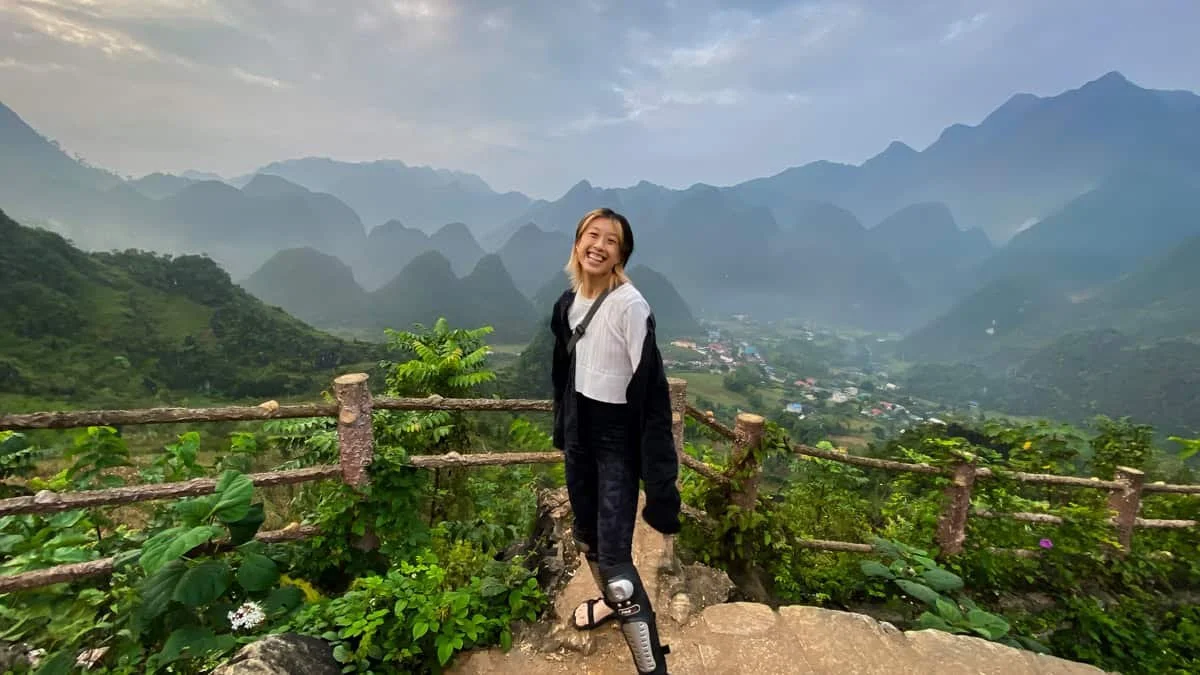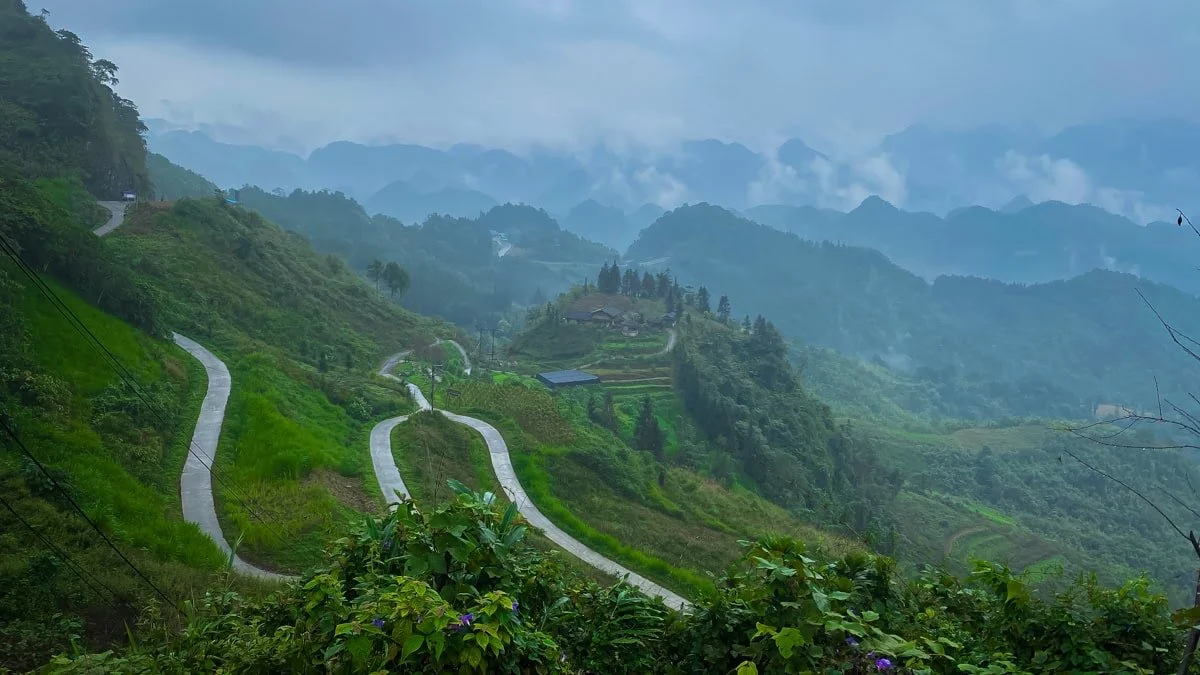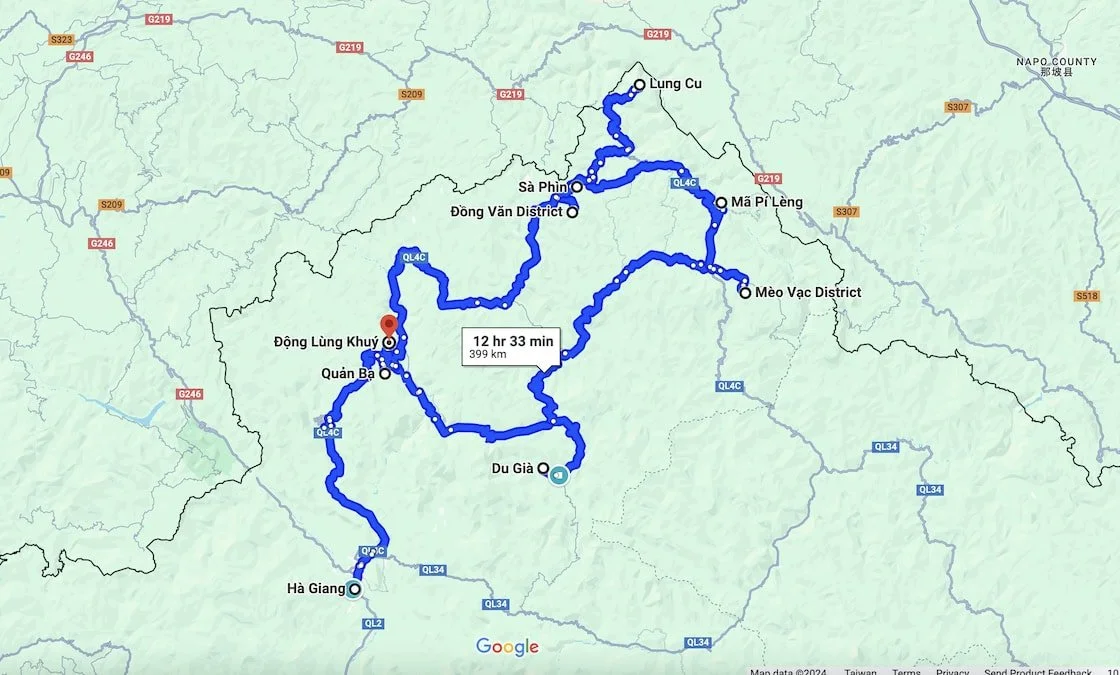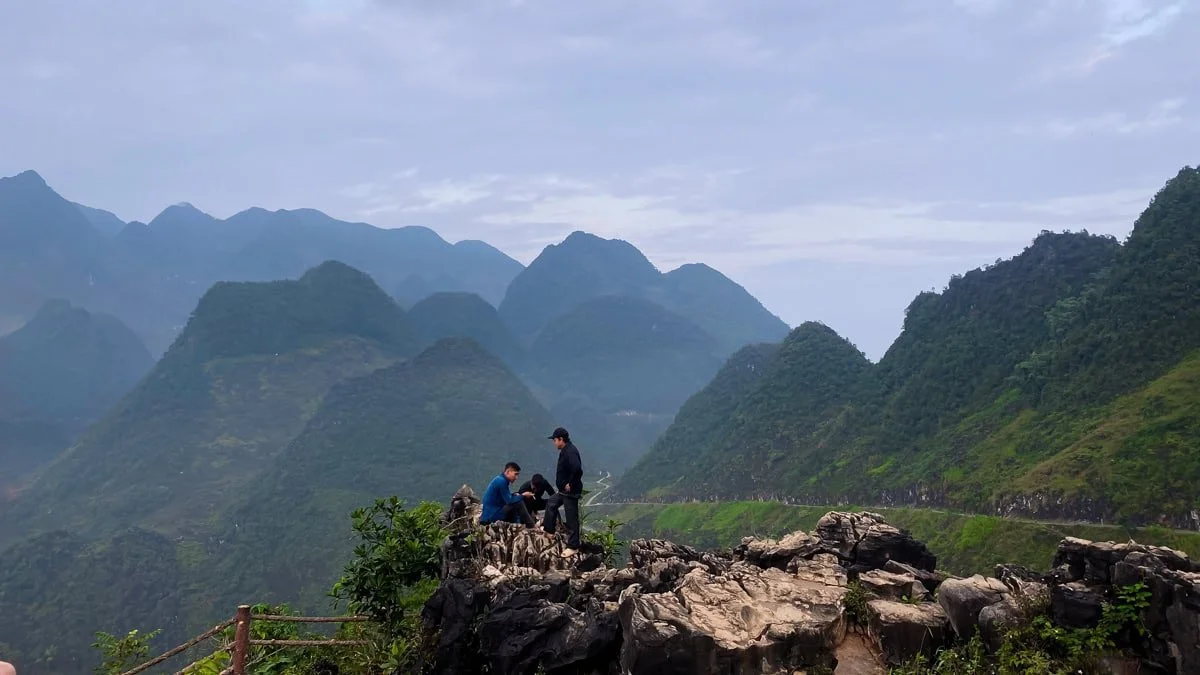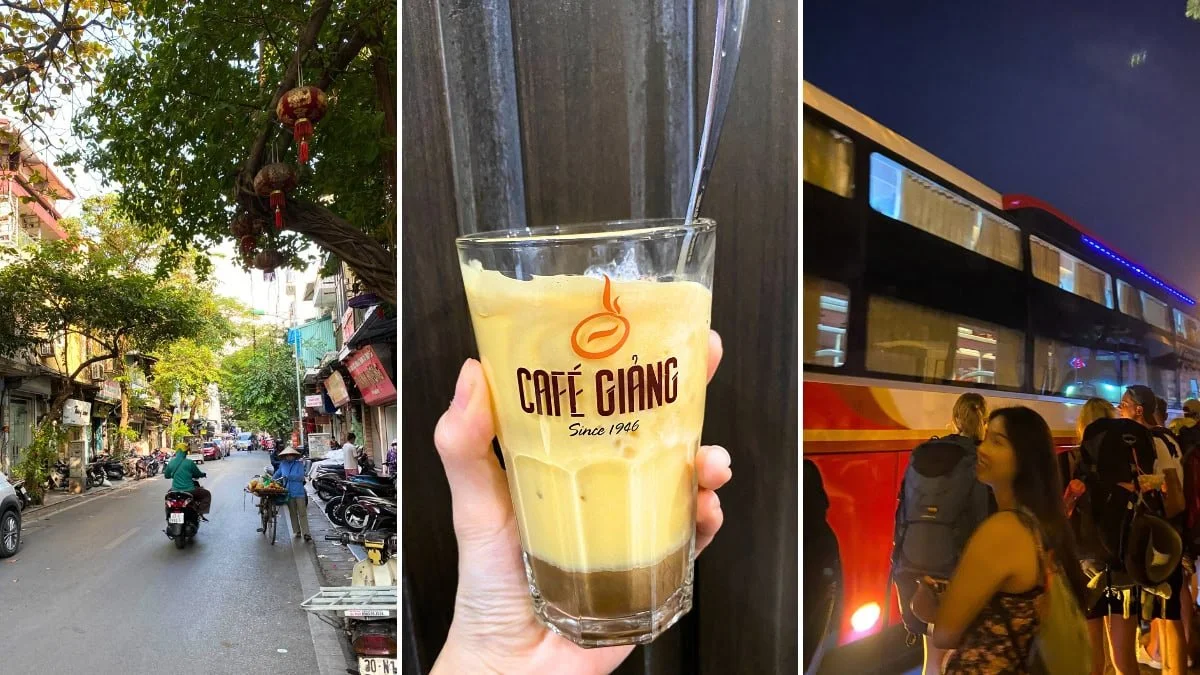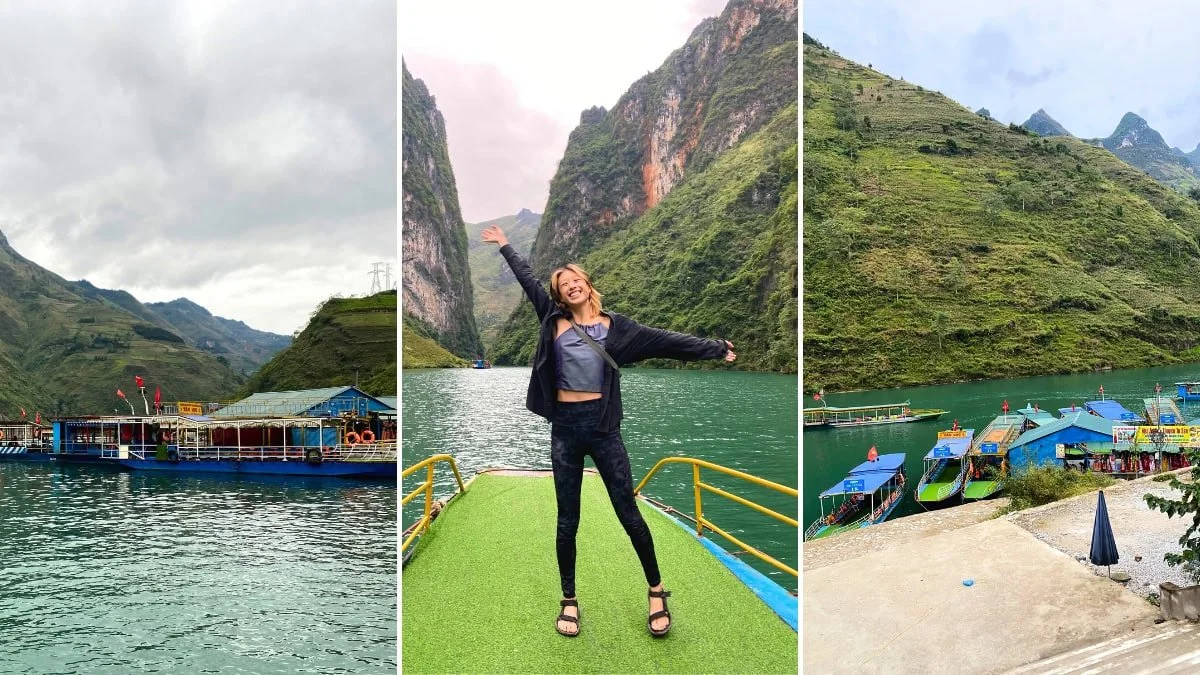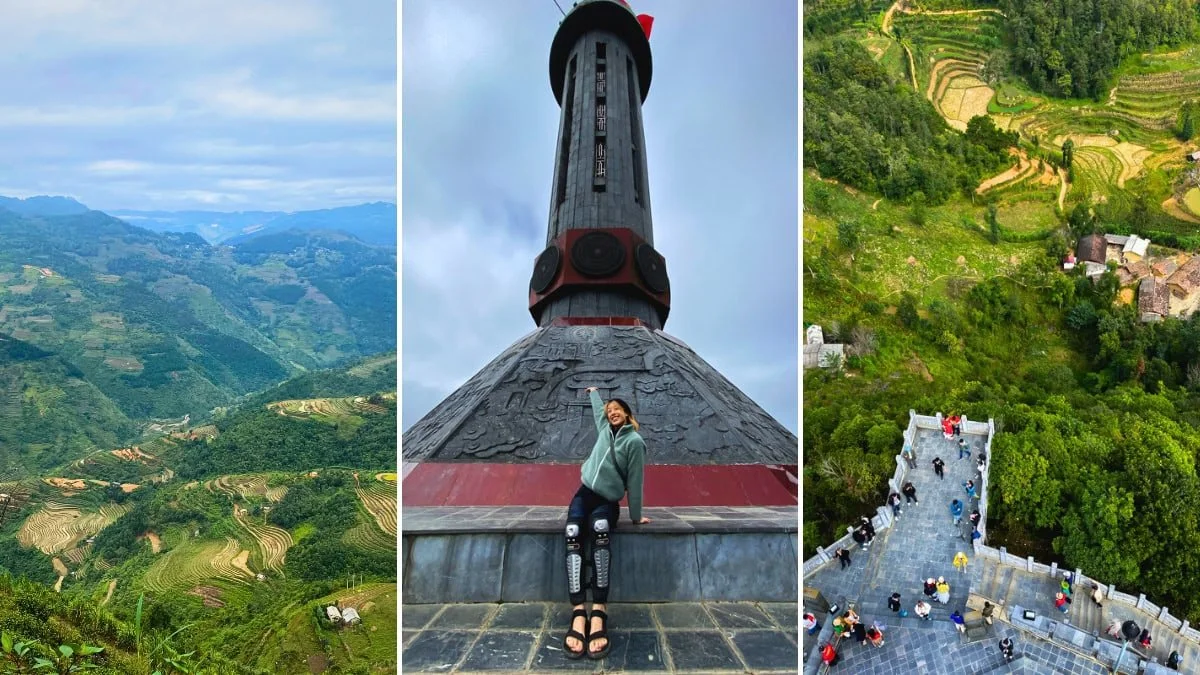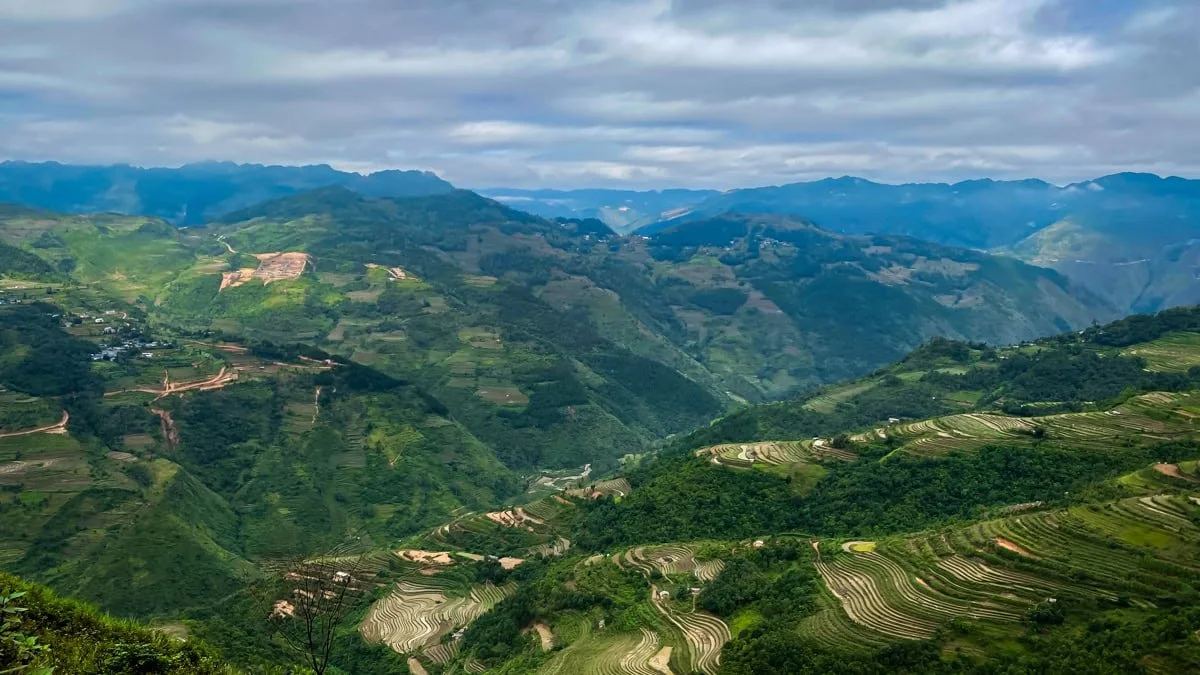Ha Giang Loop Tour Review
I started my one-month trip through Vietnam with a 4-day tour of the Ha Giang Loop, a multi-day motorbike tour that takes you through the northern mountains of country all the way up to the Chinese border.
When researching this experience, I looked up several tour operators and it looked like QT Motorbikes and Tours had the most positive reviews so I booked the standard all-inclusive tour for four days and three nights from Hanoi.
It was an unforgettable start my trip and this is an honest review of my experience.
-
Intro
→ About The Ha Giang Loop
→ About The QT Motorbikes Ha Giang Loop Tour
→ Ha Giang Loop Map4 Day Itinerary With QT Motorbikes and Tours
→ Day 0.5: Exploring Hanoi, Checking In, Overnight Sleeper Bus
→ Day 1: Ha Giang - Quan Ba - Du Gia (120 km)
→ Day 2: Du Gia - Meo Vac - Ma Pi Leng Pass - Dong Van (110 km)
→ Day 3: Dong Van - Lung Cu - Sa Phin - Yen Minh - Dong Van (150 km)
→ Day 4: Dong Van - Luong Khuy - Tam Son - Ha Giang (70 km)Honest Review of The QT Motorbikes and Tours Ha Giang Loop Tour
→ Was It Worth It?
→ Pros and Cons
→ Lessons & Final Thoughts
About The Ha Giang Loop
The Ha Giang Loop spans approximately 350 km from Quan Ba District, and weaves through Dong Van, Meo Vac, and Yen Minh, before finally returning to Quan Ba.
It takes you on narrow rugged roads that wind through some of the most stunning, untouched landscapes of Vietnam and is a popular choice for young adventurers who love nature and want a chance to experience authentic Vietnamese culture through slow travel.
Because the roads are so precarious and cell phone service is at a minimum, I recommend that you do a tour with local operators. They know the land in and out, and have local contacts in case of emergencies (and emergencies do happen).
About The QT Motorbikes Ha Giang Loop Tour:
Before we begin, here are some FAQs about doing a guided tour of the Ha Giang Loop.
Most tour operators offer 3-6 day itineraries. The recommended tour is 4 days and 3 nights, which gives you plenty of time to soak in the experience but is still brief enough that you get to visit other places in the country.
You can choose to hire an easy rider or rent a motorbike and ride the loop yourself. My recommendation is to ride pillion (as a passenger), especially if you don't have an international motorbike license or much experience riding in rough conditions. It's the safer option and gives you a chance to relax and enjoy the views.
The tour that I booked included: all meals and accommodation; an easy rider if you choose to hire one; all fuel costs and full cover of any motorcycle damage; protective gear including helmets, elbow pads, and knee pads; all entrance tickets and permits; an overnight bus from Hanoi; and a free dorm bed when you arrive in Ha Giang. Each tour is different so you should definitely check the details when you book!
A group tour with an easy rider costs roughly $315. Self-driving options are a little cheaper and private tours are obviously more expensive.
Ha Giang Loop Map
The standard tour takes you through this route: Ha Giang - Quan Ba - Du Gia - Meo Vac - Ma Pi Leng - Dong Van - Lung Cu - Sa Phin - Yen Minh - Dong Van - Luong Khuy - Lam Son - Ha Giang.
There are plenty of detours and side roads for extending or shortening the route, but for the most part, they try to stick to the itinerary.
Ha Giang Loop Tour From Hanoi: 4 Day Itinerary With QT Motorbikes and Tours!
I actually booked my tour directly with QT Motorbikes and Tours through their website but if you prefer to have all your tours and bookings in one place, they’re also listed on Viator. So without further ado, here's a review of my Ha Giang Loop experience with QT Motorbikes and Tours!
Day 0.5: Exploring Hanoi, Checking In, Overnight Sleeper Bus
Arriving In Hanoi
I started my month-long adventure in Vietnam by flying into Hanoi and taking the bus straight to Old Quarter.
I knew that I would take the overnight bus to Ha Giang that evening, so I checked my luggage into storage with WhaleLO Luggage Storage and headed out to explore for a few hours.
After wandering the quaint alleys for a few hours (super safe, super cute, 10/10 recommend except for the Vietnamese traffic), I grabbed an egg coffee, enjoyed some banh mi, and then picked up my luggage before heading over to Buffalo Hostel to check in.
Checking In
QT Motorbikes and Tours actually gave me the option for a hotel pick-up but since I had just arrived, I told them that I didn't have a hotel and they provided me with a meet-up location instead.
There were about 30 people or so who gathered at the hostel, and after checking in and confirming my booking, we all walked together to a larger road where the overnight sleeper bus was waiting for us.
Overnight Sleeper Bus
The sleeper bus was surprisingly nice!
There were three rows of bunk beds in each aisle and you were able to (almost fully) lie down when settled in. You have to put your backpack between your feet and it might be a little small for tall people, but I'm on the smaller side (5'4'' / 110 lb | 164 cm / 50kg) so it worked out alright for me.
One thing that you will have to get used to is the incessant honking.
Drivers in Vietnam use their horns to give other drivers a heads up that they're around the corner. It makes driving a little safer because people can rely not only on sight, but also on sound, to know that there's another bike, car, or bus nearby.
The first hour as they make their way out of Hanoi was definitely the most disruptive, but it gradually gets a little quieter throughout the night. Don't be surprised if a sudden loud honk wakes you up in the middle of your sleep though.
Day 1: Ha Giang - Quan Ba - Du Gia (120 km)
Arrival
We arrived at QT Guesthouse in Ha Giang around 3am.
The tour operator offers a complementary dorm bed between arrival and tour start, so we settled in and got a few more hours of shut-eye. Heads up, it's a little musty and cramped in there (at least when I visited), but at least there's somewhere to sleep and shower.
After a quick wash and nap, we headed downstairs for breakfast and check-in. At this point, you'll gather your clothes, cash, and essential documents for a day pack to take on the tour and leave the rest of your luggage behind at the hostel. (Here's a full packing list for the experience.)
We then signed waivers; got geared up with helmets, knee pads, and elbow pads; and got paired up with our drivers for the experience!
✨ Tip: They put your day pack in a plastic bag and strap it to the back of their bikes. You won't be able to access it until evening, so make sure that you have a smaller fanny pack or crossbody bag for your phones, money, and sunscreen to use during the ride!
Beginning The Tour
We began the trip by driving north on the Road of Happiness out of Ha Giang City.
It takes a while to adjust to riding behind someone, but you get used to it after the first 30 minutes or so. Hold on to the back of the bike (or your driver) and use your legs to absorb the shock from any bumps in the road.
They take breaks at local coffee and tea houses every few hours or so, so you'll have a chance to grab some snacks and stretch your legs from time to time.
On the first day, the tour takes you through the Quan Ba mountain pass, Dong Van Geopark, Heaven's Gate, and Fairy Hills. You'll stop for lunch in or around the small town of Tam Son.
Lunch
Lunch is standard Vietnamese fare. They make it pretty approachable with ingredients that Westerners are used to. We had spring rolls, tomato egg, tofu, chicken and local vegetables.
It's pretty good at first, but you'll soon realize that the same foods are served at almost every stop along the way. Honestly, we got sick of it pretty fast.
I think that they cook these mild and inoffensive meals to make it easier for people who might not be used to different cuisines, but I wish it were a little more exciting and that we got to experience that cultural exchange through food.
Dealing With Rain
After lunch, it started raining. Ha Giang is notorious for unpredictable weather, but luckily, our tour guides had plastic ponchos for everyone to use.
They were actually pretty effective but I recommend bringing your own waterproof layers if you can. They also had super cute waterproof bootie covers to keep your shoes dry!
We continued our ride into the mountains of Ha Giang towards the picturesque village of Du Gia. I've seen some photos of tour groups that take the travelers to the waterfall, but because I visited during winter, we skipped that stop.
Settling Into The Homestay
At Du Gia, we checked into our homestay, dried off, and got settled in for dinner. It was a really nice establishment with a pool, canopied coverings, and large open areas for dining and sleeping.
We had classic Vietnamese home-cooked dishes for dinner, and were introduced "happy water" for the first time.
"Happy water" is rice wine. During dinner, your tour guides will go around and teach you a chant to get the party started.
It goes something along the lines of this: một, hai, ba, dzô / hai, ba, dzô / hai, ba, uống which means one, two, three, cheers / two, three, cheers / two, three, drink!
When you're all done with drinking and partying for the evening, you'll wash up and head to bed!
Day 2: Du Gia - Meo Vac - Ma Pi Leng Pass - Dong Van (110 km)
Riding, Riding, Riding
We started the day with a simple breakfast of crepes, put on our ponchos, and then headed back out on the road!
Day two passes surprisingly quickly. You get into a meditative state when riding along those winding roads and I often found my mind wandering to different unrelated problems or processing things that I had been putting off.
It was also really beautiful to notice the slight changes in foliage and geological formations as we traveled through different parts of the region. The limestone rocks were so different from anything I had ever seen before!
Ma Pi Leng Pass + Nho Que River
We stopped for lunch at the town of Meo Vac and then made our way slowly up towards the Ma Pi Leng Mountain Pass. From 1500 m above sea level, we got a nice taste of what was to come next!
The Nho Que River sits at the bottom of the pass and is famous for its enchantingly turquoise waters. It originates in China, snakes its way through the highlands of Dong Van, and eventually joins the Gam River in Na Nat.
We made our way down the valley, took a shuttle to the marina, and headed out onto the river in a small vessel. The boat tour was about 40 minutes long and while it was a short ride, it was still a nice change of pace.
After our tour, we headed back up the mountains and made our way back to Dong Van.
Exploring Dong Van
We had dinner at our hostel (along with happy water, of course), and then the group gathered downstairs for more drinks and karaoke.
It was unexpectedly cold on our trip so most of the group ended up buying new sweaters and jackets along the way. Almost all of the garments in market had (fake) brands and logos on them which I knew I wouldn't wear in my everyday life, so when I saw this plain fleece jacket for 80,000 VND, I snagged it up in an instant.
As someone who cares about sustainable fashion, it was disheartening to hear that the tour attendees who bought clothes planned to trash their new garments right after the adventure. It just goes to show how little value we assign our clothes and how throwaway culture has really permeated our society.
Day 3: Dong Van - Lung Cu - Sa Phin - Yen Minh - Dong Van (150 km)
Lung Cu Flagpole & Chinese Border
We continue our drive north!
After breakfast of noodles at the hostel, we made our way to Long Cu--the most northern point of Vietnam. The climbed the Lung Cu Flagpole and enjoyed panoramic views of Vietnam on one side and China on the other.
The drivers played this shuttlecock game as they waited. They kicked a little feathered ball around in a circle and it was really cute to see! Some of our tour members also joined in!
Vuong Vhinh Duk Palace
We're finally at the turning point!
From the northernmost point, we headed back south towards Sa Phin, where we made a stop by the one-hundred-year-old palace of Vuong Vhinh Duk, the king of the H'mong people.
The palace was built in 1914 and survived two major wars. It's created with a beautiful blend of traditional Chinese and H'mong architectural styles and surrounded by peaceful pine forests and carefully curated gardens. Our tour leader gave us a quick history lesson about the king and then we had a chance to walk through the palace.
Heading To The Homestay
Since we had a late start to the day, we had to rush our way through the rest of the afternoon.
The official itinerary says that we'll make our way through the Song La River valley and stay the night in Nam Dam, but our tour group had to make a pivot and we ended up staying in Dong Van.
It was a cute little homestay and at this point, we were all pretty tired, so we had an early dinner and called it a night.
Day 4: Dong Van - Luong Khuy - Tam Son - Ha Giang (70 km)
Lung Khuy Cave
We're finally on the last day! At this point, almost half our group was sick and everyone was pretty exhausted, but we still carried on!
After breakfast at the homestay, we made our way to Lung Khuy Cave, one of the most prominent heritage sites of the Dong Van Karst Plateau.
We parked in a nearby village and trekked 1.5km uphill towards the entrance. I personally really enjoyed the hike as it offered sweeping views of the nearby mountains, but some of my tour members had a much more difficult time.
The cave itself features over 400 meters of well-constructed metal walkways that offer excellent vantage points to admire the stalactites and cave ponds that formed over thousands of years. It's pretty hot and mildly claustrophobic at points, so just keep that in mind before entering. Tall folks might also need to duck quite a bit!
Unexpected Rockslides!
After the cave, we headed back to Tam Son to enjoy lunch and then slowly made our way back to Ha Giang.
It had rained every day until that point so about an hour out from town, we ran into a rock slide!
The road was entirely closed and officials said that it would take at least a few hours to clear the rubble. There was a huge traffic block with other motorcycles, busses, and cars completely stuck at a standstill.
We were all pretty stressed and concerned that we would miss our transportation back to Hanoi, but about 30 minutes into the wait, our tour group got the green light to go ahead. We carefully made our way through with the drivers expertly navigating pieces of rock and stone blocking off the road. Boy, was I grateful to be a passenger at that time!
✨ Side-Note: but this is another example of why it's so important to buy travel insurance and why you should tip your tour guides well. There were so many points during the trip where I thought, "wow, I definitely couldn't have done that myself and would've been stranded out in the elements instead."
Back To Hanoi
We took a side loop back onto the Road of Happiness and got dropped off at a different hostel where we had dinner, said our goodbyes, and hopped back on the overnight bus to Hanoi!
The bus arrived around 3am in the morning and at that point, you're all on your own. I ended up going back to Buffalo Hostel where we had gathered and spontaneously booked a night there.
Honest Review of The QT Motorbikes and Tours Ha Giang Loop Tour
Was It Worth It?
10/10 worth it! The experience was completely different from what I expected, but I would still recommend it to anyone visiting Vietnam.
Expectation: otherworldly landscapes and high-energy fun
Reality: long meditative stretches, learning to prioritize your wellbeing, unexpected bouts of community and an exercise in compassion
Slow travel is all about growth. It’s about diving into the unknown and learning about how you respond to unexpected circumstances.
There are some travel experiences where you learn by engaging with the outside world and I thought the tour would offer something like that. I thought I would see more than I saw, and be able to immerse myself in the nature and landscapes that we passed through.
In actuality, I learned just as much, but more about my internal world than the external world.
It was a reflective experience and the juxtaposition between my physical experience and internal thoughts were where the growth happened.
Pros and Cons:
What I Enjoyed:
Beautiful scenery
Meditative experience
Authentic engagements and insights
Great people (tour drivers + some guests)
Weirdly enough, I enjoyed the Ha Giang Loop most for the camaraderie.
During our first lunch as a tour group, I connected with some individuals that were less about the party experience, and more about authentic connection and introspection. I was really nice to be able to relate that deeply in such a short amount of time.
Additionally, because we were in northern Vietnam, some of the drivers actually spoke mandarin! We were able to have some nice conversations and it was through those exchanges that I was able to learn more intimately about how they saw life.
What I Disliked:
Ignorant young Europeans on a gap year
Physical exhaustion
Too much drinking
Ironically, one of the biggest challenges that I faced on the loop was the tour group that I was with.
It largely consisted of young Europeans that saw Vietnam (and Southeast Asia as a whole) almost as a rite of passage into adulthood. There were moments of ignorance that were offensive and definitely triggered my childhood trauma of growing up as “other” in the states. Re: “ew, what’s in your lunchbox” memories.
Reflecting on it now, I should’ve responded with more compassion because there were definitely moments in my early twenties where I also didn’t know better. However, what’s done is done. Lesson learned for next time.
Lessons & Final Thoughts:
The Ha Giang Loop Tour was definitely one of the most memorable parts of my trip in Vietnam. I'm not sure if I would do it again, but it's one of those bucket list items that I think is worth checking off during your first time in the country.
Some Final Tips For Your Adventure:
Get travel insurance. Safety on the loop is somewhat questionable so you want to be protected just in case.
Be smart about how you pack. Being prepared will keep you warm and comfortable so that you can thoroughly enjoy the trip.
Expect to be physically tired. Four days on the road is a lot for anyone!
Use a Viettel Sim Card. They were the only carrier that had stable service on the loop.
Don't expect to get any work done. I packed my laptop but it ended up just being excess weight.
Tour organizers partner with a lot of hostels in the area. It might be worth it to reach out to the place you're staying at and ask if they can help you book a Ha Giang tour. The people I met were given a free night before or after the tour at Buffalo Hostel as part of their tour package.
Go with a small group of people that you trust. It's fine to experience as a solo traveler and you’ll definitely make friends along the way, but traveling with friends ensures that you have a community that you vibe with.
Stay open and receptive. Each experience is vastly different as it depends on your tour group and the conditions on the trail at that point in time. The Ha Giang Loop is an exercise in trust so just lean into the experience!
For more about Vietnam and travel through Asia, check out Is Vietnam Safe To Visit?, The Ultimate Thailand Bucket List, and my Lanyu, Taiwan (Orchid Island) Guide!
PIN THIS FOR LATER
